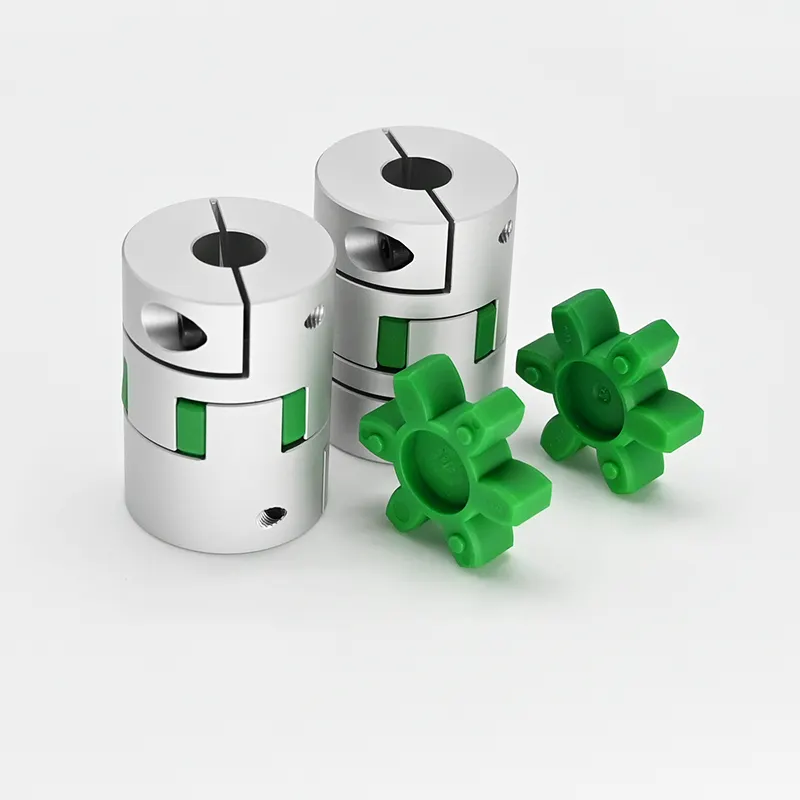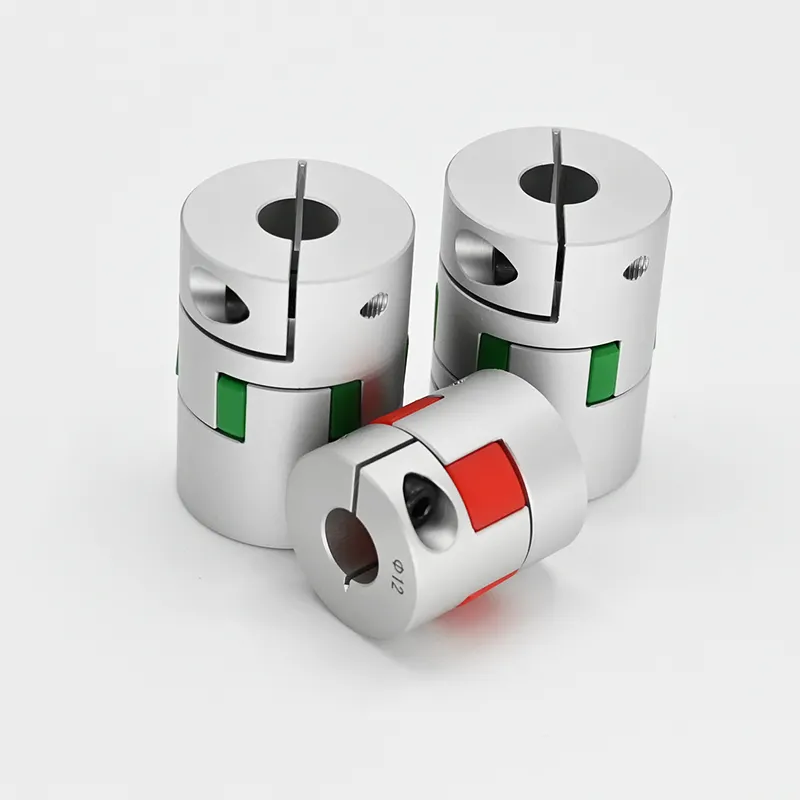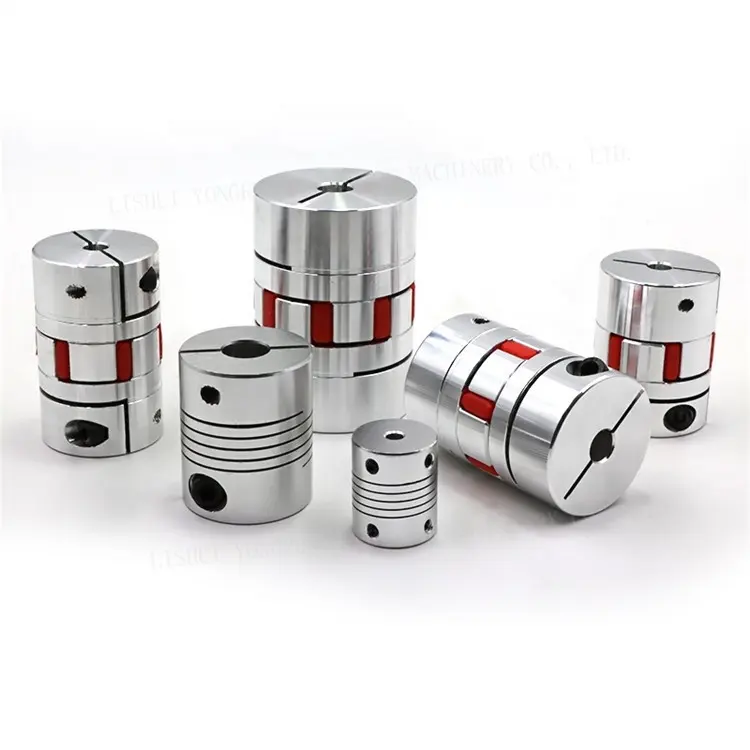Product Description
Cast Iron Flexible Jaw Coupling for General Shaft Connection
Features
1. Split in half design for simple installation, maintaining free
2. High misalignment capacity
3. Facility protection for a twirl, twist, impact, and abrasion
4. No lubrication for polyurethane flex element
5. Available for bore-to-size hubs and taper lock bushes
6. Low noise
Product Description
|
Size |
Type |
A |
B |
D |
E |
Standard |
Metric bore |
Inch bore |
||
|
bore |
Min |
Max |
Min |
Max |
||||||
| L035 |
1 |
16 |
20.5 |
6.6 |
/ |
3 |
3 |
8 |
1/8" |
3/8" |
|
L050 |
1 |
28 |
43.2 |
15.6 |
/ |
6 |
6 |
15 |
3/16" |
5/8" |
|
L070 |
1 |
35 |
50.8 |
19 |
/ |
9 |
9 |
19 |
3/16" |
3/4" |
|
L075 |
1 |
45 |
54.7 |
21 |
/ |
9 |
9 |
25 |
3/16" |
1" |
|
L090 |
1 |
54 |
54.7 |
21 |
/ |
9 |
9 |
28 |
3/16" |
1 1/8" |
|
L095 |
1 |
54 |
63.7 |
25.5 |
/ |
9 |
9 |
28 |
3/8" |
1 1/8" |
|
L099 |
1 |
64.5 |
72.5 |
27 |
/ |
12 |
12 |
35 |
7/16" |
1 3/8" |
|
L100 |
1 |
64.5 |
88.5 |
35 |
/ |
12 |
12 |
35 |
7/16" |
1 3/8" |
|
L110 |
1 |
85 |
108 |
43 |
/ |
15 |
15 |
48 |
1/2" |
1 7/8" |
|
L150 |
1 |
96 |
115.4 |
45 |
/ |
15 |
15 |
48 |
5/8" |
1 7/8" |
|
L190 |
2 |
115 |
133.4 |
54 |
101.6 |
19 |
19 |
55 |
5/8" |
2 1/4" |
|
L225 |
2 |
127 |
153.4 |
64 |
108 |
19 |
19 |
65 |
3/4" |
2 5/8" |
Related Products
Company Profile
FAQ
Q: How to ship to us?
A: It is available by air, by sea, or by train.
Q: How to pay the money?
A: T/T and L/C are preferred, with different currencies, including USD, EUR, RMB, etc.
Q: How can I know if the product is suitable for me?
A: >1ST confirm drawing and specification >2nd test sample >3rd start mass production.
Q: Can I come to your company to visit?
A: Yes, you are welcome to visit us at any time.

Contribution of Jaw Coupling to Equipment Longevity
Jaw couplings play a vital role in enhancing the longevity and reliability of connected equipment in mechanical power transmission systems. The design and features of jaw couplings contribute to minimizing wear, reducing downtime, and protecting the equipment from harmful forces. Here's how jaw couplings contribute to equipment longevity:
- Shock Absorption: Jaw couplings have elastomeric spider inserts that act as shock absorbers, dampening vibrations and impact loads. This helps in protecting the connected equipment from sudden shocks and extends its operational life.
- Misalignment Compensation: In real-world applications, shaft misalignment is common due to thermal expansion, machine settling, or manufacturing tolerances. Jaw couplings can tolerate a certain degree of misalignment, reducing stress on bearings, seals, and other components of the equipment.
- Overload Protection: During overloads or torque spikes, jaw couplings can flex slightly, absorbing excess torque and preventing damage to the equipment. This overload protection feature prevents catastrophic failures and extends the life of mechanical components.
- Backlash Reduction: Excessive backlash in a power transmission system can lead to inaccuracies in motion control and wear on components. Jaw couplings are designed to provide low backlash, enhancing precision and minimizing wear on gears and other sensitive parts.
- Resilience to Contaminants: Jaw couplings often feature enclosed designs that protect the elastomeric spider from contaminants like dust, dirt, and moisture. This helps in maintaining the coupling's performance and preventing premature failure due to external elements.
- Low Maintenance: Compared to some other types of couplings, jaw couplings require minimal maintenance. Regular lubrication and inspection of the coupling can significantly extend its life and keep the connected equipment running smoothly.
- Easy Installation: The simple and compact design of jaw couplings makes them easy to install and integrate into various mechanical systems. Proper installation ensures efficient power transmission and reduces the chances of component damage.
Overall, jaw couplings contribute to equipment longevity by providing protection against shock loads, compensating for misalignment, preventing overloads, reducing backlash, and offering resilience to environmental factors. By selecting the right jaw coupling for the application and following proper maintenance practices, users can maximize the lifespan of connected equipment and improve the overall efficiency of their mechanical systems.

What are the cost implications of using jaw couplings compared to other coupling types?
When considering the cost implications of using jaw couplings compared to other coupling types, several factors come into play. Jaw couplings offer certain advantages and disadvantages in terms of initial cost, maintenance, and overall performance. Here's a breakdown of the cost considerations:
- Initial Cost: In terms of initial cost, jaw couplings are generally more budget-friendly compared to some other coupling types such as gear couplings or disc couplings. Jaw couplings have a relatively simple design, using fewer components, which often makes them more economical to manufacture and purchase.
- Maintenance: Jaw couplings have a reputation for being low-maintenance couplings. Their elastomer spider is a wear-resistant and replaceable component, which means that in case of wear or damage, only the elastomer needs to be replaced rather than the entire coupling. This feature can contribute to lower maintenance costs and reduced downtime compared to couplings with more complex designs that require complete replacements when worn or damaged.
- Performance: The cost implications of jaw couplings compared to other types are also influenced by performance considerations. Jaw couplings provide good misalignment compensation and damping of vibrations, making them suitable for a wide range of applications. However, for specific high-torque or high-precision applications, more specialized coupling types like grid couplings or disc couplings may be required. The higher performance capabilities of these couplings might justify their higher initial cost in certain scenarios.
- Application Requirements: The cost-effectiveness of jaw couplings versus other types depends on the specific requirements of the application. If a coupling's design features align well with the application's needs, such as handling moderate misalignment and torque levels, then a jaw coupling may be the most cost-effective choice. On the other hand, if the application demands exceptional torque capacity, high precision, or extreme environmental conditions, a more advanced and costly coupling type may be necessary.
In summary, jaw couplings generally offer a cost advantage in terms of their lower initial cost and relatively low maintenance requirements. However, the most cost-effective choice depends on the specific application and its performance demands. It is essential to evaluate factors such as torque requirements, misalignment compensation, maintenance needs, and operating conditions to determine the best coupling type that balances performance and cost-effectiveness.

Use of Jaw Couplings in Various Industries for Power Transmission
Jaw couplings are widely used in different industries for power transmission due to their many advantages, including their ability to handle misalignment, shock loads, and vibrations. Some of the industries that commonly use jaw couplings include:
- Manufacturing: Jaw couplings are extensively used in manufacturing machinery such as conveyors, mixers, and packaging equipment.
- Automotive: In the automotive industry, jaw couplings are employed in various applications, including engine-driven accessories and conveyor systems in assembly lines.
- Agriculture: Farming equipment, such as tractors and harvesting machines, often use jaw couplings to transmit power from the engine to different attachments.
- Material Handling: Jaw couplings are found in material handling equipment like forklifts, cranes, and hoists.
- Water and Wastewater: Pumps and compressors used in water and wastewater treatment plants frequently utilize jaw couplings for power transmission.
- Food and Beverage: Jaw couplings are used in food processing machinery where cleanliness, reliability, and flexibility are essential.
- Textile: Textile manufacturing equipment, such as looms and spinning machines, often use jaw couplings to transmit power from motors to various components.
- Packaging: Packaging machines and equipment benefit from jaw couplings' ability to absorb shocks and vibrations.
- Printing: Printing presses and related machinery commonly use jaw couplings for their precise power transmission.
These are just a few examples, but jaw couplings are found in numerous other industries where power transmission and motion control are critical aspects of the equipment's operation. Their ease of installation, maintenance, and high-performance capabilities make them a popular choice for a wide range of applications.


editor by CX 2023-11-16
